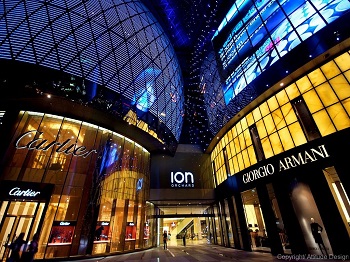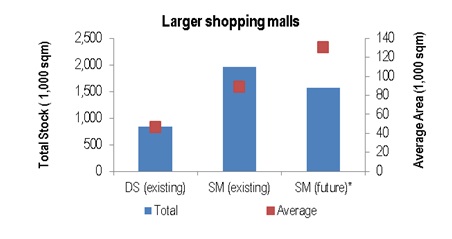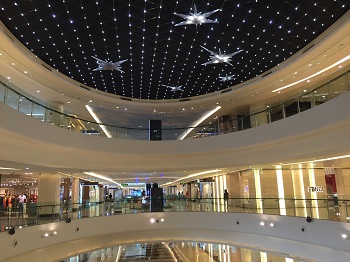Shopping Malls
Changing the retail landscape in Tianjin
By Lesley Chai, Senior Analyst, JLL Tianjin
 In the first half of 2015, several department stores in Tianjin closed because of fierce competition, which led many to believe that the market in the city is struggling. However, that is not the whole story. Here is our view of what the main trends of shopping malls are, and how such projects improve the Tianjin retail environment.
In the first half of 2015, several department stores in Tianjin closed because of fierce competition, which led many to believe that the market in the city is struggling. However, that is not the whole story. Here is our view of what the main trends of shopping malls are, and how such projects improve the Tianjin retail environment.
1.Diversity of location
Unlike department stores, which focus on the core submarket, developers of shopping malls are more willing to build their projects as new retail destinations. A convenient location close to a residential community encourages residents to go shopping whenever they want, rather than wait until the weekend because of the long distance. The new malls also help areas move away from the homogenised department stores that have long been present in many areas.
As more residents in the city are taking the metro as their main form of transportation, most shopping malls that have accessibility to subway stations enjoy higher foot traffic, making it easier to obtain high sales. However, locations further from the city centre see a greater proportion of customers arrive via car. Therefore, freeway access is also a key factor.

Source: JLL Research
Note: * SM (future) refers to the number of projects open in 3Q 2015 - 2018ÃÃÂ
2.Larger size
Shopping malls in Tianjin have almost twice the space of department stores.By the end of 2018 estimates suggest the average GFA of shopping malls will be more than 120,000 sqm.
Developers tend to build large retail spaces to create "one-stop shops" that can attract people for an entire day. Large space makes it possible to introduce different retail categories.
Shopping malls with a large public space, such as an atrium and lounge, have enough space for operators to host exhibitions and shows that can attract more shoppers. Moreover, a big outside square in front of shopping malls tends to attract more people. In summer, people dance, walk or play games with their kids in such spaces, attracting high foot traffic.
 3.Changing brand mixes
3.Changing brand mixes
Customer habits changed recently. Some clothing or cosmetics stores may experience declining sales, even though footfall is still high, because customers may only go to do some window shopping, purchasing instead on the internet or even buying things overseas. The challenge from the development of e-commerce and the high rate of travel abroad has pushed developers to change their strategy and upgrade to more attractive and experience-focused brand mixes.
Food and beverage (F&B) brands have become the main driver of retailer demand, as peopleÃâs first priority in visiting these projects is to eat. Most developers have realised that F&B outlets are not be affected by online shopping or the price gap. No matter whether people just go to do some window shopping, they may still need to eat or drink.
Another hot retail category over the past three years has been fast fashion. Since brands change their products rapidly and their relatively cheap price is more acceptable, sales are not influenced by online shopping as much as general clothing. As new high quality shopping malls opened in Tianjin, such as Joy City, Galaxy International Shopping Centre and Riverside 66, fast fashion brands expanded their stores rapidly in these projects.
The kid's sector, especially children's entertainment and education brands, has become established in shopping malls because of growing demand. Young couples are willing to spend more time and money on their kids, especially on early education. Also, developers want to introduce these brands to support sales in other sectors. For example, while the children are having classes, their parents probably do some shopping, buy clothes or watch movies in the theatre.
 4.Coordination with the Internet
4.Coordination with the Internet
Bricks-and-mortar shopping malls have been under pressure from growing online shopping, which pushed developers to start trying omni-channel retailing. Coordinating with the Internet is one of the methods that can attract shoppers by providing convenient online payment or sharing promotional information. Tianjin Joy City is a typical and successful example. Shoppers can find store information, do group buying and book movie tickets through the store's own app, first launched at the end of2014. In April 2015, Joy City opened a new VIP centre called Liangshiju, which is the first online to offline experiential store in Tianjin.
Shoppers benefit a lot in terms of convenient locations and a better shopping atmosphere with more brands and rest space. However, there are also some challenges shopping malls may face in the future.
Although brand mixes in shopping malls are more attractive compared with the brand mix in traditional department stores, randd mixes among most shopping malls seem similar and it is not easy to make them stand out. As a result, it is hard for shoppers to distinguish one project from another.
 Another challenge that future shopping malls will face is that developers tend to build larger projects, making it harder to achieve a high pre-leasing rate. If developers open their malls with a lot of vacant space and empty stores, shoppers will not have a good shopping experience, and this may create a negative reputation for the project. In addition, during the emerging period of a new project, developers may keep rents at a relatively low level because the priority during the first leasing cycle is pushing up the occupancy rate. About three years later after a new project opens, a higher base rent may be introduced in an attempt to increase revenue for the developers.
Another challenge that future shopping malls will face is that developers tend to build larger projects, making it harder to achieve a high pre-leasing rate. If developers open their malls with a lot of vacant space and empty stores, shoppers will not have a good shopping experience, and this may create a negative reputation for the project. In addition, during the emerging period of a new project, developers may keep rents at a relatively low level because the priority during the first leasing cycle is pushing up the occupancy rate. About three years later after a new project opens, a higher base rent may be introduced in an attempt to increase revenue for the developers.
A new retail format " the lifestyle centre " is becoming popular in Tianjin. These are retail projects that have a very strong food and entertainment focus. They are often located in historic buildings or settings. For example, in Tianjin, lifestyle centres have appeared in the Minyuan Stadium Area, which is located in the Five Boulevards Historical Architecture District. Since more good restaurants and bars have opened in the area, people tend to go there to eat while enjoying the nice weather. As F&B and entertainment brands are also the attractions that most shopping malls lean on, a more competitive retail environment has arrived for shopping malls.
Facing these challenges, developers of shopping malls in Tianjin need to keep following the changes in customer behaviour and assimilate the successful experience of other cities while being creative on retail strategies.
--END--